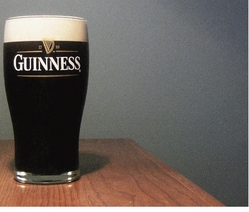
Each day, an average of about 5.5 million pints of Guinness are consumed across the world. Staggering when you consider that 240 years ago, in 1769, the first batch of six and a half barrels of Guinness was exported from Ireland to England.
But it was perhaps what Arthur Guinness intended when he began brewing porter and ale 10 years earlier, after he had signed a 9000-year lease on a run-down brewery at Kings Gate, Ireland.
History
Arthur was born in 1725 in Co. Kildare, the son of Richard Guinness, land steward to the Most Reverend Arthur Price, archbishop of Cashel. One of his duties was to supervise the brewing of beer for the workers on the estate and, as Arthur grew up, he helped his father.
In 1752, Arthur was left an inheritance of £100 by Archbishop Price and he used the money to start his own brewery in Leixlip with his brother Richard. Three years later, he handed Richard the business and left for Dublin where he started his own brewery.
The premises at Kings Gate at the time consisted of four acres with a copper, a kieve, a mill, two malt houses, stabling for 12 horses and a loft to hold 200 tonnes of hay. Guinness leased the property for 45 pound sterling a year. Ever since, the St James's Gate Brewery has been at the heart of the success of Guinness.
Arthur Guinness died in 1803 and his son Arthur Guinness II took over. By 1833, St James's Gate Brewery had become the largest brewery in Ireland and in 1862 the GUINNESS trademark label was introduced.
Making Guinness
Guinness stout is made from water, malt, barley, hops and brewer's yeast. It is treated with isinglass made from fishes' air bladders.
The barley is first converted to malt, which involves steeping it in water and then drying it. Before malting, the barley grain is hard, after malting it is crunchy and edible.
First, the malt is crushed, then mixed with flaked and roasted barley. This produces a substance called grist. The grist is weighed and then hot water is added and then mixed at about 66 degrees Celsius. The result is a porridge-like substance called wort which is then passed through a sieve. The liquid which is left is quite sweet; it is then placed into a copper kettle. The remaining grains are then sold as cattle feed.
The hops, that give the stout its bitter taste, are added at this stage where it is all boiled for around 90 minutes.
The next stage is fermentation. This is the process which takes place when yeast is added in the presence of CO2. It is then matured for a number of days where a secondary fermentation takes place which adds to its unique taste.
The process lasts about ten days. One of the most important parts of the finished product is carbon dioxide which gives the beer its creamy head. Before being blended into beer it is clarified, analysed and tasted. Before being transferred to kegs, it is tasted a second time and when it passes this test nitrogen is added. This gives the draught Guinness, as we know it, its creaminess and smoothness for which it is famous.
Nutritional Facts
Despite its reputation as a "meal in a glass", Guinness only contains 198 calories per imperial pint, fewer than skimmed milk or orange juice.
Draught Guinness and its canned counterpart contain nitrogen as well as carbon dioxide. Nitrogen is less soluble than carbon dioxide, which allows the beer to be put under high pressure without making it fizzy.
The perceived smoothness of draught Guinness is due to its low level of carbon dioxide and the creaminess of the head caused by the very fine bubbles that arise from the use of nitrogen and the dispensing method. "Original Extra Stout" contains only carbon dioxide, causing a more acidic taste.
Although Guinness may appear to be black, it is officially a very dark shade of ruby. Studies claim that Guinness can be beneficial to the heart. Researchers found that anti-oxidant compounds in Guinness, similar to those found in certain fruits and vegetables, are responsible for health benefits because they slow down the deposit of harmful cholesterol on the artery walls.
Its alcohol is low enough to have a relaxing effect. The bottle-conditioned product may produce a mild laxative effect due to the live yeast and there is medical folklore about Guinness and stout, in general. "In some countries, stout is seen as an aphrodisiac, or as a beneficial bath for new-born babies."